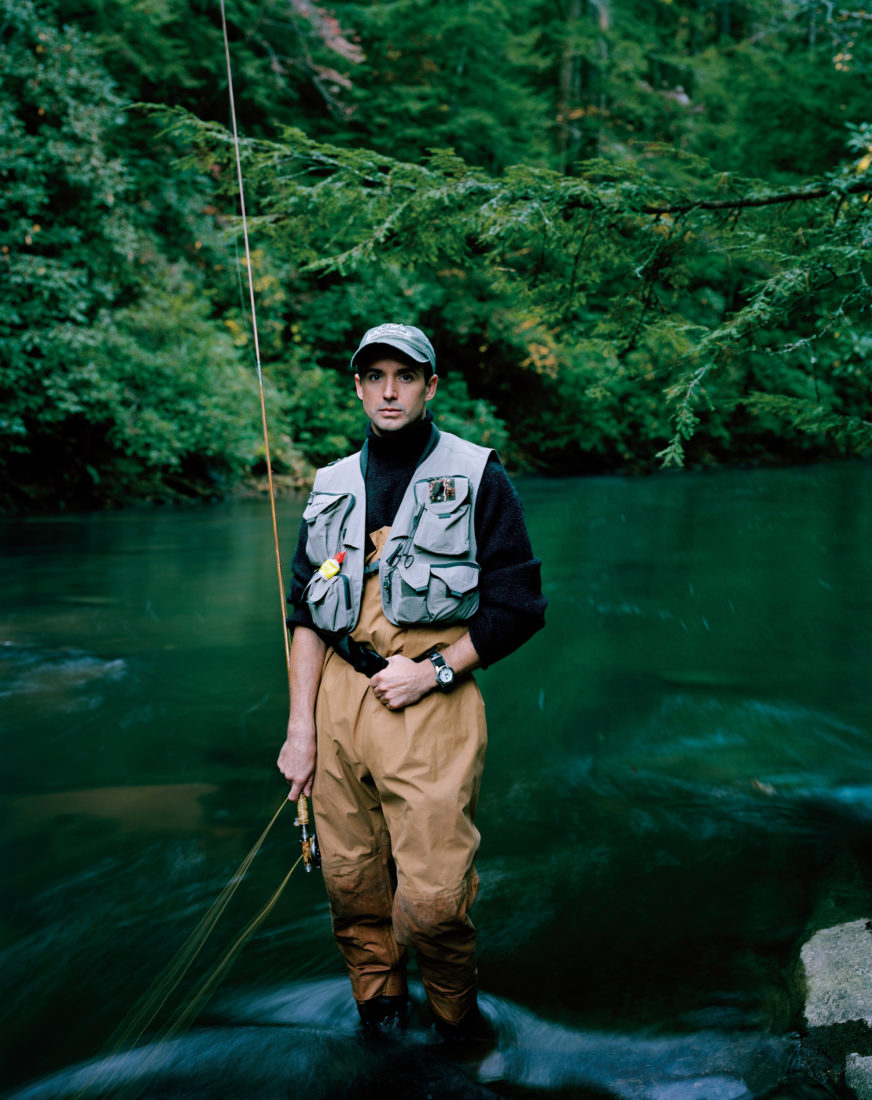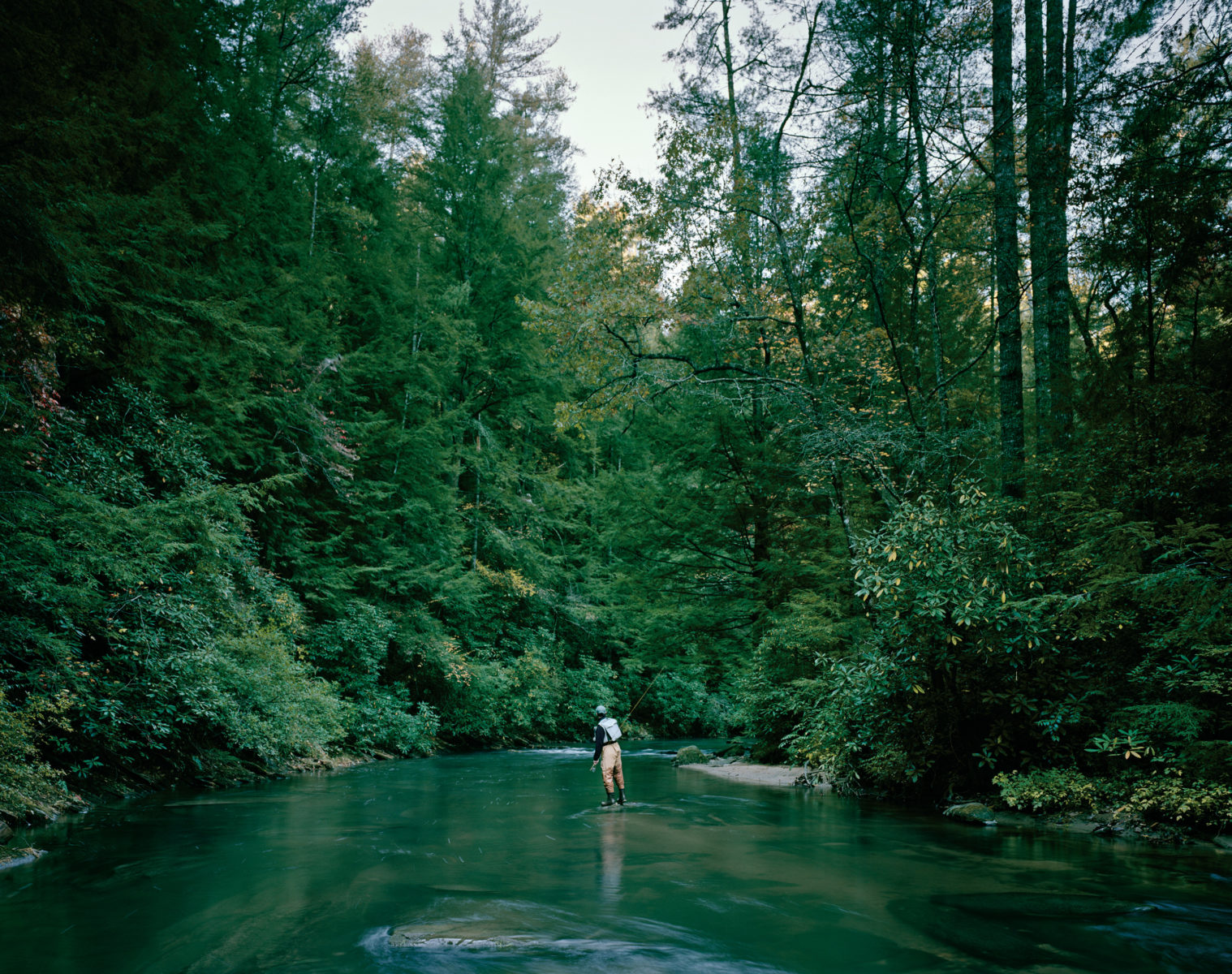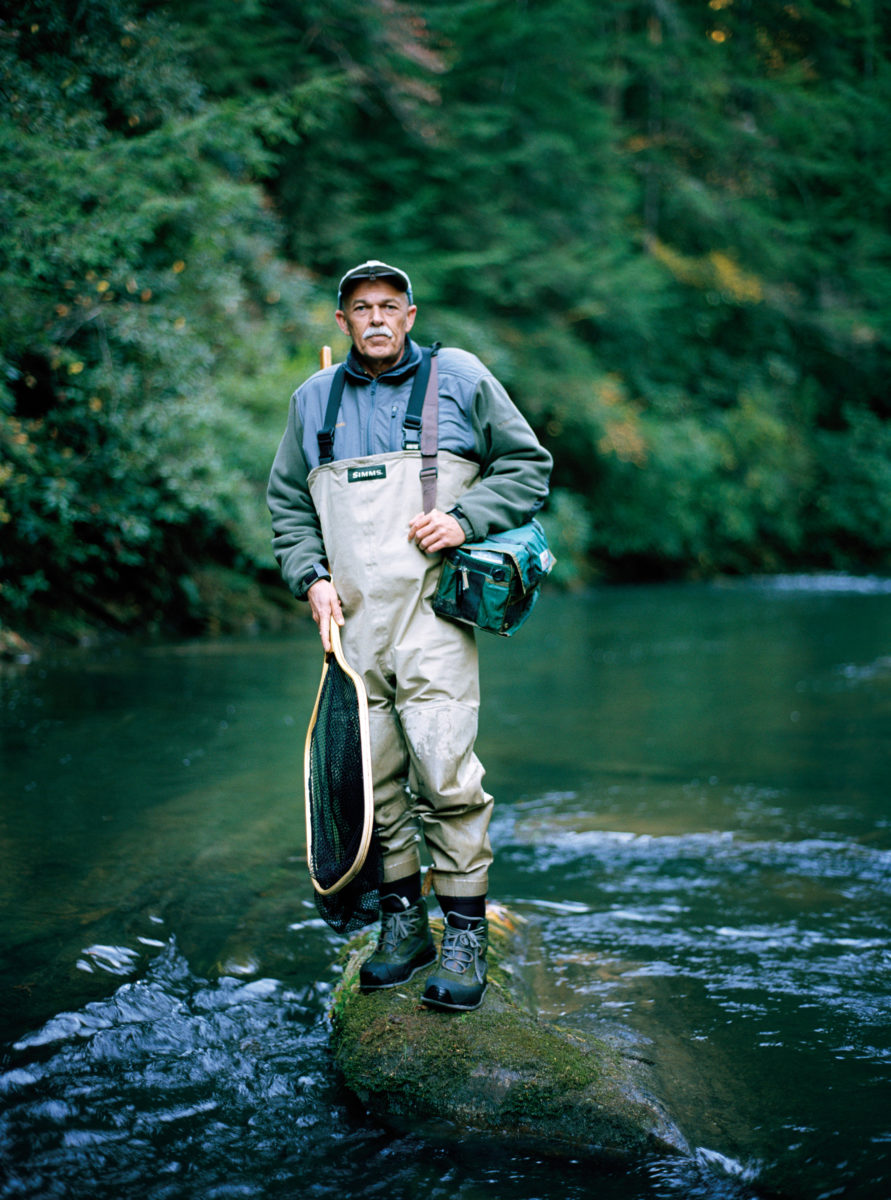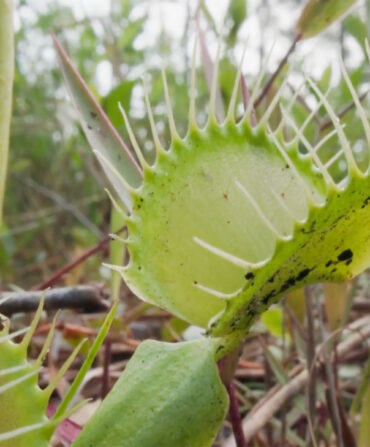Sporting
Casting a Spell
Bamboo fly rod maker Bill Oyster and best-selling author George Black fish the beautiful Soque River in North Georgia

Photo: Andy Anderson
Almost nothing about the movie had stuck with me. As a native-born Scot, I still winced whenever I thought of Cyd Charisse’s accent (“There’s a laddie, wearrry and wanderin’ frrree”). Other than that, nothing but the image of Gene Kelly peering down at the lights, and the rooftops emerging from the mist. That image, inevitably, was in my mind as I navigated the twists and turns of Georgia Highway 197, through the fog and the cold evening rain, until at last I glimpsed a nimbus of light and the indistinct shape of buildings and an asphalt driveway with a sign that said “Brigadoon Lodge.”
Inside, there was everything a wearrry and wanderin’ laddie could want: a blazing log fire in a great room filled with antlers, Persian rugs, and Audubon prints, and a voice with the soft cadences of Atlanta, saying, “Oh, you poor man, sit down and let me pour you a single malt”— the voice belonging to the owner of Brigadoon, Rebekah Stewart. She handed me a glass and we sat by the fire. A young man rose to greet us, slight and black-haired, looking younger than his thirty-five years: a bamboo fly rod maker from nearby Gainesville with an ascending reputation and the improbable name of Bill Oyster.
Just before we arrived, Rebekah said, she’d had a brilliant idea. She was helping out again this year with the annual fundraiser for the Carter Center in Atlanta. Her friend Jimmy had offered a day of fishing on the Soque, himself and Rosalyn as companions and Ted Turner as guide. The advance bidding had already reached six figures. Now, Rebekah would complement that by asking Bill Oyster to make a presidential rod, seal and all. Jimmy would fish it for a year, then turn it over to be auctioned in 2008. As she laid out the scheme, Bill grinned shyly.
With the rain still beating steadily down, the three of us ventured out onto the covered porch and looked down on the Soque River. The sound of the water was loud, and in the soft glow of the garden lights we saw that it was running high, opaque, and mudbrick-red. There would be no fishing in the morning, although Rebekah assured us that the river came down quickly after rain and we’d be out there by mid-afternoon, hip-deep in the Soque, stalking trophy trout.

Photo: Andy Anderson
By the next morning, the sun had broken through and we could appreciate the beauty of our physical surroundings. Across from the main lodge a sheer rock face reared forty feet or more above the river, higher than the Soque was wide, and although the sky was clear by lunchtime, the sun never fell on this long pool, keeping it cool and shaded, just the way trout like it. Yet, trout were the last thing on Rebekah Stewart’s mind when she bought this property fifteen years ago. After a successful Wall Street career in institutional asset management, she’d come looking for a weekend getaway in the Blue Ridge Mountains. Driving down Route 197 she’d seen a hand-painted sign on a square of particle board: For Sale, followed by a telephone number. She’d scrambled down the slope to the riverside and tried to walk upstream, but the dense forest of oak, maple, hemlock, birch, mountain laurel, rhododendron, and deciduous magnolia had swallowed her whole. It was love at first sight: fifteen acres in the form of a perfect teardrop, an inholding in the Chattahoochee National Forest, enclosed by the better part of a mile of tumbling freestone water.
For two years Rebekah lived here in a tent, since there was no house on the property. For one nine-month stretch she never set foot outside her fifteen acres. “I cleared out the springs with spades and shovels and buckets,” she said. “I pruned the trees with fingernail scissors — not for the sake of the trout, but just because I wanted double blooms on the rhododendrons. To me the river was just a garden feature. I put rocks in the water to enhance the sound. And all that ended up being beneficial to the fish.”
Rebekah’s real estate agent had always pointed out the potential of the Soque as a trout stream, and after a while she decided to add a few fish of her own. Not many: 125 of them in 1991, with small supplemental stockings thereafter, and regular feeding. That was all that was needed, since the fish took well to the cool temperatures, the natural tree canopy, and the steady flow of oxygenated water from the artificial dams, and they’ve reproduced happily here for more than a decade. Paying guests started coming to Brigadoon for the trout, and the reputation of the place was cemented when Ted Turner, no stranger to the enchantments of fly fishing, bought the neighboring property. Turner took to hanging around the fly shop that occupies the front part of Cragganmore, one of Brigadoon’s two satellite lodges. You can understand why this place is so expensive, one visitor said: she’s got Ted Turner working in the fly shop.
On the second morning, Henry Williamson, one of Rebekah’s guides, woke us in the pre-dawn darkness by yodeling like a coonhound. After the gourmet extravaganza that the Brigadoon chef had whipped up the previous evening, the breakfast that Henry brought us was a large tray of sausage biscuits from McDonald’s. Having himself been up since four thirty, he jiggled from one foot to another while we stumbled over to the coffee pot.

Photo: Andy Anderson
The Soque is lined with ancient rhododendron and mountain laurel, and the atmosphere is magic.
One of our party remarked on Henry’s striking resemblance to the Democratic political consultant James Carville. It was a fair observation if you kept the bald head and the manic intensity, added a white toothbrush mustache, and replaced the Louisiana accent with the exaggerated vowels of North Georgia. Henry is pals with the man who played the banjo in Deliverance, which was filmed a few miles from here in Rabun County, named for a Georgia governor who ended up in prison. The banjo player, Henry told us, now washes dishes in his family’s restaurant over in Clayton.
When we’d demolished the biscuits, Henry led the way down to the Soque, carrying over his shoulder a landing net of prodigious dimensions that gave some foretaste of the size of the Brigadoon trout. We stood on the bank and looked at the water. It was running clear now, and you could see big fish finning in the deeper runs.
This seemed a good opportunity to ask Bill Oyster how he’d come by his unusual name. Originally Irish, he said, but put through contortions by an immigration officer at Ellis Island. I’d met many bamboo rod makers, and no two were alike in either background or temperament: liberals, conservatives, machinists, carpenters, photographers, college professors, jazz musicians, Zen Buddhists, recovering drunks. Bill Oyster’s case was different again: he’d been a bicycle racer, and a good one. His father was a peripatetic cowboy, and the family had moved around the South and the West a lot before finally settling in Georgia. As a teenager, Bill cropped tobacco during the summers for $18 a day to pay for flying lessons. “I wanted to be a pilot in the Marines,” he said, “but then I realized that war wasn’t just high-speed fun and games.” So he made restless moves, changed colleges twice, studied English, philosophy, and studio art, thought of maybe becoming a teacher. “But then I got into bike racing hot and heavy,” he told me. “Won the Southeastern Conference, went pro.”
It was a grueling existence. With sixty races a year, Bill was on the road half the time, and fly fishing became his escape from the brutal, ego-driven world of head-to-head competition. Then, after the 1996 Olympic trials, where he placed in the top quarter, Bill had a mountain-biking accident that broke his collarbone, shoulder blade, and two ribs. Laid up to recuperate, he found to his delight that his wife, Shannen, kind of enjoyed having him around the house.

Photo: Andy Anderson
Out on the stream he yearned for the best of fly rods, but realized he couldn’t afford them, and from there it was only a short step to making his own. Not that this new life slowed him down altogether, he said. “I got into it pretty fast and furious, the same way I did everything else.”
When Bill’s interest in rod making was first piqued, he bought every book he could find on the subject, then headed north to take lessons from a master craftsman in Maine, where the modern bamboo fly rod was born. In that respect, Gainesville, Georgia is an unexpected place to find a bamboo rod maker, although, curiously enough, Bill lives just a five-minute walk from another well-known craftsman named Gary Lacey, who has recently started making fly rods for L.L. Bean.
It was a Maine craftsman named Hiram Leonard who first perfected the art around 1870. On one of his journeys through Maine, Henry David Thoreau encountered Leonard aboard a stagecoach. “He had a fair white complexion,” Thoreau wrote, “as if he had always lived in the shade, and an intellectual face, and with his quiet manners might have passed for a divinity student who had seen something of the world.”
Within a decade Leonard had gathered a group of acolytes around him and moved them to a village on the fringe of the Catskills in New York State, where American fly fishing had first flourished. From there, each of these gifted apprentices — Edwards, Payne, Hawes, Thomas — founded his own dynasty, passing on from father to son the arcane techniques of transforming six finely tapered strips of bamboo, each an equilateral triangle in cross section, into the perfect tool for catching fish. The craft remained largely a northeastern affair, though in time new offshoots emerged in California, Montana, and the upper Midwest. But by the mid-1950s most people pronounced it dead, a victim of the postwar revolution in synthetics and the U.S. trade embargo on China — the only source of the raw material needed for fine fly rods, an unusually resilient species of bamboo called Arundinaria amabilis.

Photo: Andy Anderson
Southern guide Henry Williamson. Henry's camaraderie on the river is a true joy, and his knowledge of fishing is formidable.
For the next 20 years only a handful of diehards clung to the old ways. But then Nixon went to China and the embargo ended. At about the same time, Hoagy Carmichael Jr., son of the legendary songwriter, befriended a dying New York rod maker named Everett Garrison and decided to unpack everything the old man knew into a book. It was filled with graphs and tables and engineering diagrams that laid bare the inner workings of a great fly rod. These had always been closely guarded trade secrets. Now they were available to everyone, and Bill Oyster, like most aspiring rod makers, bought a copy of Hoagy’s book. Today the craft is as healthy as it’s ever been: There may be a thousand people or more out there making bamboo fly rods, with perhaps one in five doing so on a fulltime basis.
I asked to see the rod that Bill was carrying. It was an exquisite thing, seven-and-a-half feet long, in two pieces, built for a five- or six-weight line, heat-treated to a deep, dark brown, embellished with narrow wraps of translucent silk, its tip just a sixteenth of an inch wide, the overall design borrowed from a celebrated Michigan rod maker of the mid-century named Lyle Dickerson. It was clear that, like every other rod maker I’d met, Bill Oyster was a perfectionist; there’s no other way to do this. Making a fine bamboo fly rod takes forty, sixty, eighty hours of highly skilled work, and Bill spends an additional week peering into a microscope to add the complex engraving on all his nickel silver fittings. “It’s hard to think artistically when you’re just trying to eat, keep the power on,” he said. “So yeah, maybe I’m obsessive-compulsive. Not with other things — I mean, it’s not as if I get up, make the bed, tuck my shirt in. But with this, every rod I make I want to make it better. I throw away ninety percent of the bamboo I buy, burn it in the backyard. If there’s a blemish in it, it drives me nuts.”
As a result, these things don’t come cheap. A rod maker who’s new on the scene may get away with charging a thousand dollars; for the top craftsmen in the field, it’s closer to three. That sounds like a lot, but do the math: If you’re really, really good, and gifted with preternatural qualities of patience and endurance, you may make thirty or forty rods a year. Take out the overhead and you’re lucky to clear thirty thousand dollars a year. And besides, there’s a fair measure of sweat equity: Most people have to make at least twenty rods — some would even say fifty — before you can make one that’s fit to sell. Bill Oyster has made about a hundred now, in eight or nine years of hard work.
Henry Williamson was waiting for me at the edge of a pool called the Flying Goose. We chatted as I fished, using a bamboo rod of my own, by coincidence also a Dickerson design, and the conversation took some surprising turns – surprising in view of my first impressions of the man, and surprising in view of where we were, in rural north Georgia, though all that was probably no more than a reflection of my New York prejudices. Henry started off with a string of colorful political tirades. Then abruptly he asked, “Where did you go to school?”
“Oxford,” I answered.
“Is that right?” he said. “I had an uncle went to Oxford and Cambridge both. Name of Guy Davenport.”

Photo: Andy Anderson
The name was familiar to me – Davenport was a Renaissance man, a distinguished scholar-poet-writer-illustrator who’d taught for many years at the University of Kentucky. I caught a couple of trout – powerful, deep-bodied rainbows of 15 or 16 inches, one that pushed 20 – while Henry kept up his machine-gun barrage of ideas. He talked about F. Scott Fitzgerald, bemoaned the arrogance of too many fishing guides who disdained their clients, then segued into another tirade, this time about the meltdown in Iraq. “I read the Koran in college, you know,” he said. “Had an African roommate who was a Muslim. Now what in the hell are we fighting Muslims for? The Prophet Mohammed said their God was the same as the God of Abraham.”
Shaking his head, Henry picked up his net and moved off downstream, looking for Bill. He’d been gone barely five minutes when my fly, a gaudy pink San Juan Worm, stopped in mid-drift and something monstrous erupted from the water in a crash of spray. It was a broad-shouldered rainbow of 28 inches or more, at least an 8-pound fish. As it showed off its full repertoire of surging runs and airborne leaps, I hollered for Henry, needing his net. But my guide was long gone, and I had to play the fish on my own for the better part of forty minutes before it finally tired and I could coax it into the shallows.
Henry showed up a few minutes later with Bill and Rebekah, and I told them about my trout. “That’s the biggest fish anyone’s caught here this season,” Rebekah said. Henry didn’t say much; he was looking at Bill’s rod now. “Why don’t you try it?” Bill said. Henry, a graphite man, seemed dubious, and we were dubious too when he took a small dry fly from his box – a Light Cahill, size 14 – and tied it on. Bill and I had both tried dry flies earlier, but we’d concluded that the effort was futile: The Light Cahill imitates a mayfly that hatches in the warmth of summer evenings, and that was still months away. In the present chilly temperatures it was time for flies fished deep beneath the surface. Henry swished the bamboo rod back and forward a few times, getting the feel. On his third cast a fish rose gracefully through the flow of the Soque and sucked in the floating fly. Henry brought it effortlessly to hand, released it, and looked at the rod again. “You know, I ought to make one of these things myself sometime,” he said reflectively and a little out of character. Less shyly this time, Bill Oyster grinned.
Dates of note in the life of The Bamboo Fly Rod

Andy Anderson
c. 200: Fishermen in Macedonia fashion the first artificial flies as a means of catching trout
1496: Publication in England of Treatyse of Fysshynge with an Angler
1653: First edition of Izaak Walton and Charles Cotton’s The Compleat Angler
1732: Founding of the Schuylkill Fishing Company of Pennsylvania, the first angling club in the American colonies
1770s: Philadelphia tavern keeper Edwards Pole opens the first American fishing tackle shop, selling rods and reels imported from England
1845-65: Pennsylvania gunsmith and violin maker Samuel Phillippe, his son Solon, and craftsmen Charles Murphy and Ebenezer Green from Newark, New Jersey, develop the first American split bamboo fly rods, made with Calcutta bamboo
1871: Hiram Leonard, a celebrated gunsmith and hunter born in Maine in 1831, makes his first split bamboo fly rod and becomes the first American pioneer of the craft
1878: Loman Hawes and Hiram Leonard invent the beveling machine that allows for mass production of split bamboo strips, and the Leonard rod becomes a luxury brand
1882: Leonard moves his rod shop from Maine to Central Valley, New York, bringing apprentices—including Eustis Edwards, Ed Payne, Fred Thomas, and Hiram and Loman Hawes. Each man starts his own family dynasty 1890: Fly-casting becomes increasingly popular, propelled by lighter and lighter rods. Montgomery Ward’s catalog offers mass-produced six-strip bamboo fly rods for $1.25. Resisting market pressures, Leonard’s disciples split from him to start production of their Kosmic rod c. 1900: The Montague Rod and Reel Co. of Massachusetts begins using “Tonkin cane” as a trade name for the Chinese bamboo used in rod making. By the 1920s, stronger Chinese bamboo takes the craft of fly rod making – and fly fishing – to a new level
1929: California craftsmen E.C. Powell and Lew Stoner perfect fly rod designs of their own, breaking the northeastern domination of the craft
1950: Bamboo fly rod making is devastated by the U.S. trade embargo against China after Mao Zedong’s Communist triumph. It is not revived until the 1970s, when relations with China are restored and exports of Arundinaria amabilis are resumed
1965: Leigh Perkins buys the venerable Orvis Company, Inc. of Manchester, Vermont, and announces his intention of marketing “an Americanized version of English country living.” Its signature product will be the fine bamboo fly rod
1975 –the present: Spurred by the restoration of the China trade and a “how-to” book by Hoagy Carmichael, Jr., the craft of fly rod making undergoes a dramatic revival
Source: Casting a Spell, by George Black







